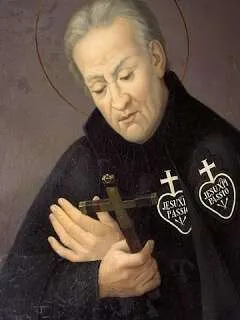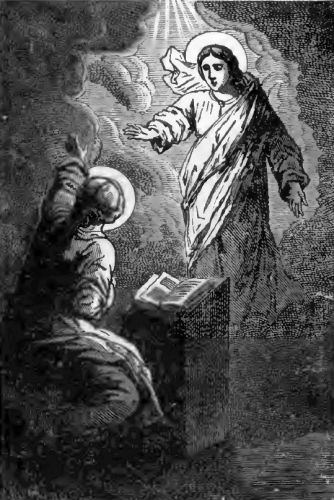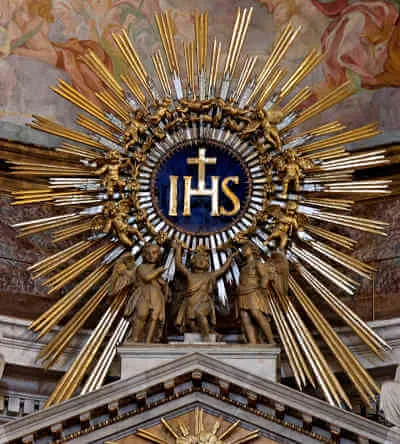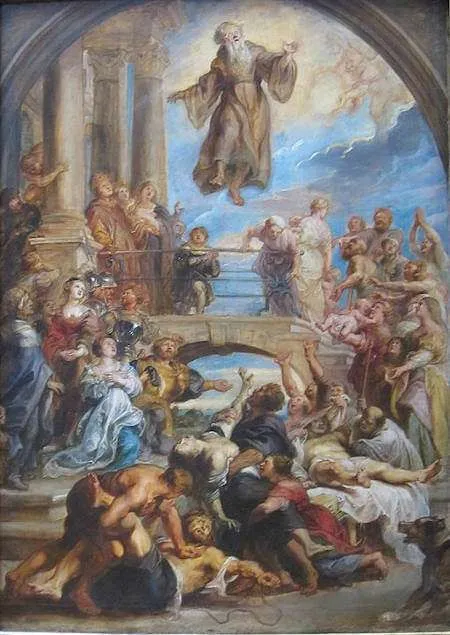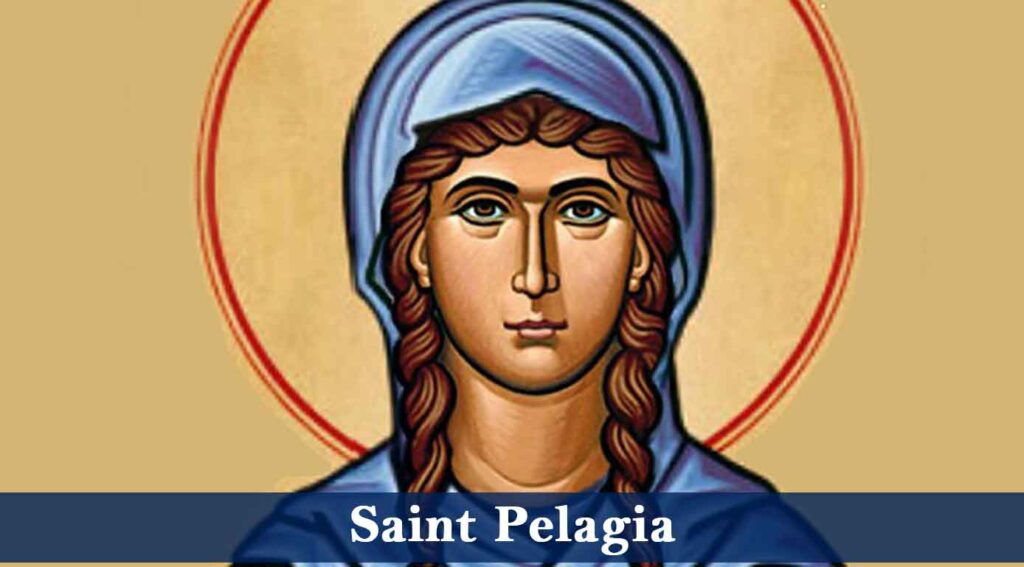1694–1775; Patron Saint of Hungary and Ovada, Italy; Canonized by Pope Pius IX on June 29, 1867
Paulo Francesco Danei, now known as Saint Paul of the Cross, was born in Ovada, in what is today northwestern Italy. In a family of sixteen, he was the oldest of the six children who survived infancy. His parents were devout Catholics who instilled their faith in their children. His father, a merchant and man of great faith, was more concerned about God and the lives of the saints than he was about worldly goods. Paul’s devout mother introduced her children to a devotion to the Blessed Mother and used to tell them about Christ’s Passion and the lives of the saints, especially the desert hermits. This sparked a great faith in Paul and a desire for prayer and solitude, a desire that never left him. He would later say of his mother, “If I am saved, as I hope through God’s mercy I will, it will be due to the training of my mother.” As a child, his prayer life grew deep, he loved to engage in mortification, and he often tearfully meditated on the Passion of Christ.
At the age of seven, Paul and his family relocated to the nearby town of Cremolino, where he received elementary education from Carmelite priests. He was a hardworking student who balanced his time of prayer and study, attending daily Mass and receiving Holy Communion as often as he could. When he turned sixteen, his family moved again, and Paul was sent to live with a host family in Genoa to complete his education.
When Paul was around twenty, he heard a sermon by his parish pastor, at which time a sudden and clear light shone in his soul that illuminated the depth of his misery. He would later refer to that moment as his conversion. Profoundly aware of his sin, he made a general confession to his parish priest, seeking to be cleansed of every sin, attachment, and disordered desire he had. This led to an increase in virtue and a desire for more prayer and penance. His penances became severe—scourging himself, sleeping on a board, fasting, and striving to enter more fully into the Passion of Christ. He said of this time in his life, “In those first years, our Lord filled me with hunger for two things: for Holy Communion and for suffering.”
As his prayer life profoundly deepened, so did his temptations. He saw the battle within himself raging, and he knew he had to be a soldier for Christ. In 1715, Pope Clement XI encouraged young men to assist the Venetian Republic in its war against the Ottoman Empire. Paul decided to join them, thinking this might be the way for him to fight for Christ. Once enlisted, he remained fervent in his prayer and virtue. One day, while waiting for deployment, he entered a Church in the town of Crema where God clearly and emphatically made it known to Paul that the battle He was calling him to fight was of a much higher and more noble purpose. As a result, he received an honorable discharge from his duties as a soldier and began his journey home. In the town of Novello, he stayed with a wealthy elderly couple who were childless. The couple became so fond of Paul that they decided to make him their heir. Paul, however, refused, since he desired nothing of this world.
Back home, Paul submitted himself to spiritual direction by his parish priest. Seeing Paul as an unusually devout young man, the priest put him through a series of tests. He showed him great severity in Confession, publicly humiliated him at times, and treated him as the worst of sinners. One day, he decided to impose an even more severe trial on Paul by ordering him to participate in a local town dance. Paul was completely opposed to the idea but obeyed. When he stepped onto the floor, however, all the strings of the instruments broke at once, bringing an end to the dance. This convinced the parish priest that Paul did, indeed, have a very special calling from God.
Since his family was of modest means, with his father always struggling to provide, Paul’s uncle, Father Christopher Danei, came up with a plan. With the permission of Paul’s parents, he found a wealthy and virtuous young woman with whom he offered to arrange a marriage. His uncle also informed Paul’s parents that he would leave all his money to Paul, so he could help provide for the family. Everyone loved the idea, except Paul. His uncle insisted, so Paul reluctantly met with her, but he knew marriage was not for him. Afterwards, his entire family continued to plead with him to wed for the family’s sake and to carry on the family name as the eldest son. Paul turned to prayer and shortly after, before any arrangements were made, his uncle suddenly died. Paul was already named the heir, but he renounced the entire inheritance, choosing only to keep his uncle’s prayerbook, leaving the rest to his family.
At the age of twenty-four, Paul was elected president of the local Confraternity at which he gave well-received regular spiritual exhortations. Soon afterward, many in the town flocked to listen to him. Around this time, he also taught catechism to children and formed an association of young men whom he would take on long walks to discuss the faith, especially the Passion of Christ, inspiring many of these young men to enter religious life. Paul also began caring for the poor and infirm, showing much devotion to those who were dying and seeing to it that they received a proper burial. He continued his apostolic works on many levels, and God gifted him with great charisms. He was given the ability to read souls and compassionately tell penitents their sins, leading to conversions and humble confessions. Paul especially worked to convert the young men who were hardened in their sins, prophesying their fate to them if they did not repent. His prophecies always came true. This won the admiration and holy fear of the townspeople, who began to consider him a living saint.
Around the age of twenty-six, Paul was introduced to three new spiritual directors who helped him immensely. His prayer was reaching the highest heights of contemplation, and God was continually speaking directly to his heart, slowly revealing His plan for Paul. One day, when Paul was returning from church, he had a vision, “Suddenly, I saw myself clothed in a tunic; a white cross on the breast; under the cross also in letters of white, the Holy Name of Jesus…” At another time, Paul had a vision of the Blessed Mother who held out to him a habit with the words, “JESU XPI PASSIO,” which means “The Passion of Jesus Christ.” Some time later, the Blessed Virgin appeared to Paul again, clothed in the habit she had shown to Paul previously. “My child! You see how I am clothed in mourning. It is because of the sorrowful Passion of my beloved Son, Jesus. You are to found a congregation in which all the members will clothe themselves in black and mourn continually for the Passion and Death of my dear Son.” Paul related all of these things to his bishop at the advice of his spiritual director, and the bishop, after consulting others, agreed that these inspirations and visions came from God. Soon after, Paul bid farewell to his family and went to the bishop’s private chapel where the bishop clothed him in the black habit, but without the emblem on the breast which would eventually mark the Passionist Congregation. The bishop then ordered him to write the Rule of the new congregation. Paul wrote the Rule during a forty-day retreat and then presented it to the bishop. After the bishop sought the advice of another priest, he approved the Rule for the new diocesan congregation of the “Poor of Jesus.”
Paul was sent to a remote hermitage to begin his new life but soon after was moved by the bishop to the church of Saint Stephen. The bishop knew Paul’s life was to be more than a life of prayer and personal sanctity: it was also to be apostolic. Once at Saint Stephen, two others joined Paul, one being his brother, John Baptist. Paul began to teach catechism at the order of the bishop and then started preaching. His preaching drew many, and conversions were plentiful. Miracles were worked, the townspeople began to turn from sin, and the Passion of Christ was ever on Paul’s lips.
In September of 1721, less than a year after Paul finished writing his Rule, he decided to travel to Rome to see the Holy Father, thinking that just like Saint Francis he would walk right into the papal palace and receive permission to found his new community. He arrived in Rome and presented himself at the papal palace, but because his poverty was evident from his clothing and exhaustion, the guards didn’t even let him pass the gate. They treated him roughly, told him that vagabonds arrived all day, and that he should go away. He then proceeded to Saint Mary Major, stopping at a fountain on the way and sharing his last loaf of bread with a beggar. At Saint Mary Major, before an ancient icon of the Blessed Mother, he made a vow to promote devotion to and grateful remembrance of the Passion of Jesus. It was through that experience of rejection, which he united with Jesus through the intercession of the Mother of God, that the Passionists’ charism became clearer to him. Soon after, he returned home to his hermitage with his brother.
In 1725, Paul and his brother went to Rome and lived in the Hospice of Saint Gallican where they tended to the suffering and dying. This experience of severe suffering became their primary source of inspiration for what would happen next. The cardinal who oversaw the hospice had a great affection for Paul and his brother. One day, the cardinal informed them that he believed they should be ordained priests, so he ordered them to prepare for ordination out of obedience. Over the next several months they intensely studied theology under a Franciscan and were ordained priests on June 7, 1727, at Saint Peter’s Basilica by Pope Benedict XIII.
Over the next fifteen years, Father Paul cared for the sick, preached missions, and lived a life of deep prayer, allowing God to work numerous miracles through him. Slowly, others joined him and his brother, and in 1741 Pope Benedict XIV gave final approval to their Rule, establishing them as the Congregation of the Discalced Clerks of the Most Holy Cross and Passion of Our Lord Jesus Christ (Passionists). From that time on, Father Paul and the Passionists continued to grow. By the time of his death in 1775, there were hundreds of brothers and priests dedicated to a life of prayer and preaching centered on the Passion of Christ. There were twelve monasteries, or “Retreats” as they called them, and there was also a monastery for contemplative Passionist nuns. In addition to leaving a written Rule, Saint Paul wrote an estimated 2,000 letters in which his spiritual advice and profound insights into Christ’s Passion are most evident.
Saint Paul of the Cross was drawn to the Passion of Christ from an early age. He discovered that his own sufferings were the most precious gift he could receive when he united those sufferings to Christ. He had a profound love for the Eucharist, his “Sacramental Spouse,” Whom he received frequently in Holy Communion, an uncommon practice at that time. His bold preaching of the Cross, flowing from his deep prayer, drew many to Christ, bringing about many conversions. Throughout his ministry, he taught on the Divine Indwelling, by which one retreats to the interior desert, in order to speak to God and lose oneself in Him. He endured fifty years of spiritual darkness but united that darkness with the sufferings of Christ, drawing him into an intimate solidarity with, and compassion for, both Jesus Crucified and the sinners He came to save. This charism forged the foundation of the whole Passionist edifice.
As we honor this great saint, mystic, and founder, ponder the simple fact that Saint Paul discovered great joy in suffering because he found Christ in suffering. This discovery was of supernatural origin and can only be understood through the light of faith. Ponder your own view of suffering and seek to discover what Saint Paul discovered, so that you, too, will come to know our Crucified Lord more deeply.
Source: https://mycatholic.life/saints/saints-of-the-liturgical-year/-st-paul-of-the-cross/

